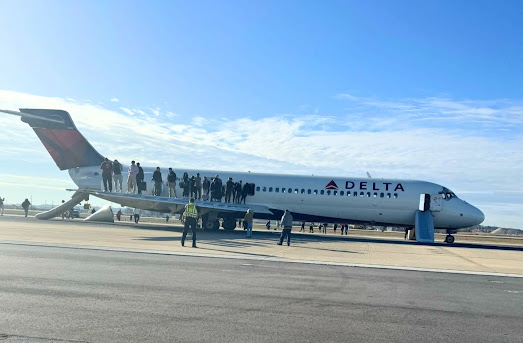This is preliminary information, subject to change, and may contain errors. Any errors in this report will be corrected when the final report has been completed.
Aviation Investigation Report - National Transportation Safety Board
The National Transportation Safety Board did not travel the scene of this incident.
Investigator In Charge (IIC): Brazy, Douglass
Additional Participating Entities:
- Patrick Lusch; FAA/AVP100; Washington, DC
- Josh Migdal; Delta Air Lines; Atlanta, GA
- Steve Haggarty; Boeing; Seattle , WA
- Richard Lewis; Rolls Royce; Bristol, OF
- Thomas Karge; BFU ; Braunschweig, OF
https://registry.faa.gov/AircraftInquiry/Search/NNumberResult?nNumberTxt=N942AT
https://data.ntsb.gov/carol-repgen/api/Aviation/ReportMain/GenerateNewestReport/199761/pdf
On February 24, 2025, at 0848 eastern standard time, Delta Air Lines flight 876, a Boeing 717- 200, N942AT, experienced smoke in the cabin and cockpit during takeoff from Atlanta Hartsfield/Jackson International Airport (ATL), Atlanta Georgia. The airplane returned to the airport, landed safely, and the crew conducted an emergency evacuation. There were 99 passengers and crew on board, and two passengers received minor injuries during the evacuation. The flight was conducted under the provisions of Title 14 Code of Federal Regulations Part 121 scheduled domestic passenger flight from ATL to Columbia Metro Airport (CAE), Columbia, South Carolina.
During the takeoff roll, flight attendants (FA) in both the forward and aft areas of the cabin saw smoke. The two FAs in the forward section first noticed it emanating from the area over the L1 door. The FA In the aft section first noticed it “coming out of all the vents”. Both the FA in the aft section and the lead FA in the forward section attempted to contact the pilots using the emergency call button but did not get a response. They also took turns using the interphone to try and announce to the pilots that there was smoke in the cabin. After takeoff, the lead FA also knocked on the cockpit door.
The aft flight attendant made a public address announcement to the passengers, advised that they were aware of and trained for the situation and to remain calm. The lead FA recalled that the smoke was very thick, and that he was unable to see past the first row of seats. A nonrevenue flight attendant who had been in a jumpseat, self-deployed to the exit row to prevent an unanticipated evacuation, or assist in evacuation if one ensued.
The pilots reported that just as the airplane rotated for takeoff, they heard the flight attendant call chime and knocking on the flight deck door. Shortly thereafter smoke was visible rising from the floor near the rear of the cockpit. They donned their oxygen masks and initially delayed responding to the flight attendant calls, as the captain focused on flying the airplane while first officer declared an emergency with air traffic control.
Shortly after takeoff, a master caution alert for smoke detected in the forward lavatory occurred. The first officer began the quick reference handbook (QRH) checklist for this alert and then attempted to communicate with the cabin crew using the handset phone. He recalled that he could hear the cabin crew, but when he spoke, they could not hear him. As the lead FA began to unlock the cockpit door, he was able to hear the first officer on the interphone advise that the pilots were aware and returning to the airport. The lead FA then relayed that information to the other cabin crew and passengers.
Soon after, an alarm warning of low oil pressure for the right engine occurred in the cockpit. The crew performed the QRH procedure which ultimately led them to shut down the right engine.
As the airplane was returning to the airport, the captain elected to change the approach from runway 27R to 27L “in order to get glidepath guidance since our visibility was restricted due to the smoke and the facemask”. The remainder of the approach and landing were uneventful.
The crew stopped the airplane on the runway after landing and the airport rescue and fire fighting vehicles arrived soon after. The pilots opened the flight deck door, noticed a “tremendous” amount of smoke in the cabin, and the captain immediately ordered an evacuation. The aft FA coordinated the evacuation through the tailcone door with no anomalies. The lead FA managed door 1L, which he initially had some difficulty opening but succeeded on his 3rd attempt. The 3rd FA managed the evacuation through the 1R door with no anomalies.
The non-revenue FA managed the overwing emergency exits evacuation. She remained on the wing with some passengers who were unable to jump from the wing to the ground. The airplane does not have evacuation slides for the overwing exits, the egress path is to slide down the trailing edge of the wing. The wing flaps were extended to 25° prior to the evacuation (in accordance with the checklist) to reduce the height from the wing to ground.
She coordinated with the other three FAs and they determined at that time, because there were no remaining risks inside or outside the cabin, the passengers remaining on both wings could reenter the cabin and evacuate using the 3 usable deployed doors slides.
The airplane was equipped with Rolls Royce model BR715-C1 engines. During a post incident examination, maintenance personnel found no oil visible in the sight glass of the right engine oil reservoir, indicating the quantity was at or near zero. Examination of the right engine’s components continues.
Qualified parties were invited to participate in the investigation. These included the Federal Aviation Administration (FAA), Delta Air Lines, and Boeing Commercial Airplanes. In accordance with the provisions of Annex 13 to the Convention on International Civil Aviation, an Accredited Representative from the Federal Bureau of Aircraft Accidents Investigation (BFU) of Germany, the State of Manufacture for the engines, was appointed to support the investigation with Rolls Royce as a technical advisor.
An NTSB flight data recorder specialist has been assigned. The investigation continues.

No comments:
Post a Comment